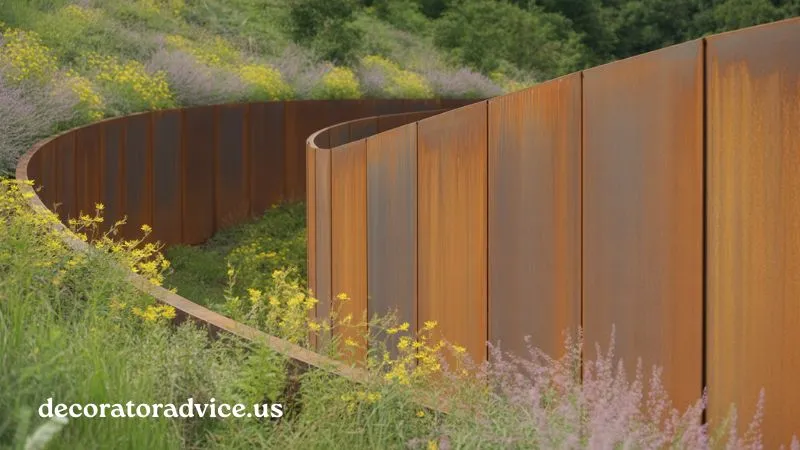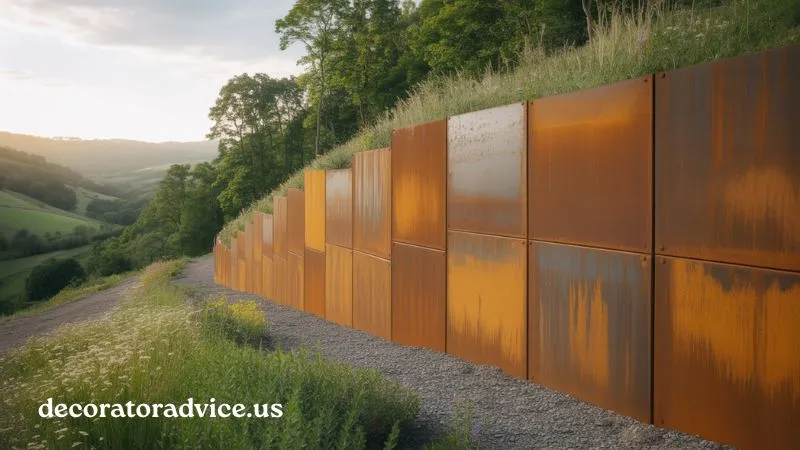Retaining walls are a staple in landscaping. They hold soil in place, create usable flat areas on sloped properties, and define outdoor spaces. Traditionally, homeowners and designers have relied on concrete, stone, or timber. But in recent years, corten steel retaining walls have emerged as a modern, durable, and visually striking alternative.
This guide explores everything you need to know about corten steel retaining walls, including what they are, cost breakdowns, benefits, design possibilities, installation considerations, and FAQs.
What Is Corten Steel?
Corten steel (short for corrosion-resistant tensile steel), also known as weathering steel, is a high-strength alloy that forms a stable, rust-like patina when exposed to outdoor conditions.
- How it works: Instead of corroding endlessly like regular steel, corten develops a protective oxide layer. This patina acts as a shield, slowing further oxidation.
- Why it matters: The steel remains structurally strong for decades while taking on an earthy, natural appearance that changes subtly over time.
Originally developed for bridges and structural applications in the mid-20th century, corten is now a favorite material for architects and landscape designers who want both longevity and visual impact.
Benefits of Corten Steel Retaining Walls

1. Exceptional Durability
Corten is engineered to last for 40–80 years, depending on environmental conditions. Unlike untreated steel or timber, it won’t rot, warp, or weaken quickly.
2. Minimal Maintenance
Once installed, there’s little to do. No painting, sealing, or staining is required. The patina is self-healing—if scratched, it naturally reforms.
3. Distinctive Aesthetic
The warm, reddish-brown finish blends beautifully with natural landscapes while offering a modern edge. Over time, it evolves, giving your wall a living, dynamic character.
4. Structural Strength
Steel walls are slim yet incredibly strong, allowing you to retain significant loads without the bulk of stone or concrete. This is especially useful in compact yards.
5. Eco-Friendly Choice
Corten steel is fully recyclable, has a long life cycle, and requires no chemical treatments. Compared to pressure-treated lumber or short-lived materials, it’s a sustainable option.
Drawbacks to Consider
No material is perfect. Here are some potential downsides:
- Runoff Staining: In the first year, rain can wash rust particles onto nearby paving or walls. Avoid placing corten above light-colored surfaces without managing runoff.
- Higher Upfront Cost: Corten is pricier than wood or standard steel. However, lower maintenance and long lifespan often balance out the investment.
- Engineering Required for Tall Walls: Walls above 3–4 feet usually require reinforcement or professional engineering to handle soil pressure safely.
Cost of Corten Steel Retaining Walls
The total cost depends on wall size, design complexity, and installation method. Here’s a breakdown:
Material Costs
- Corten Steel Sheets/Panels: $3–$10 per pound
- Pre-Fabricated Wall Systems: $40–$100 per square foot (materials only)
Installation Costs
- Professional Installation: $70–$150 per square foot (including labor, excavation, backfill, and drainage)
- DIY Raised Beds: Kits start around $200–$500 for small corten planters or modular edging
Cost Comparison
- Pressure-Treated Timber: $15–$40 per square foot
- Concrete Block: $40–$80 per square foot
- Natural Stone: $80–$200 per square foot
👉 Corten falls in the mid-to-high range, but with far less maintenance than timber and a sleeker look than concrete.
Design Ideas for Corten Steel Retaining Walls

1. Terraced Slopes
Break steep terrain into flat, usable sections. Corten walls create a bold, modern terraced look, especially when paired with ornamental grasses or succulents.
2. Raised Garden Beds
Corten steel makes excellent raised planters that double as mini retaining walls. They’re especially popular in urban gardens where space is tight.
3. Path and Patio Edging
Low corten retaining walls (12–24 inches high) neatly frame walkways and outdoor seating areas, offering a crisp transition between hardscape and softscape.
4. Feature Walls
Use corten steel as a backdrop in a courtyard or outdoor dining area. With integrated lighting, the rich tones become even more dramatic at night.
5. Mixed-Material Designs
Combine corten with wood decking, concrete steps, or stone paving for striking contrasts. The rusted steel acts as a warm accent that ties the landscape together.
Installation Considerations
1. Drainage Is Key
Like any retaining wall, corten installations must include proper drainage—gravel backfill, perforated drain pipes, and weep holes if necessary. Without it, water pressure can cause failure.
2. Choosing the Right Thickness
- Small raised beds: 3–4 mm steel is usually sufficient
- Walls up to 3 feet: 6–8 mm steel recommended
- Taller walls: 10+ mm, often requiring professional reinforcement
3. Managing Patina Runoff
Plan for rust runoff during the first year. Direct water away from sensitive areas or seal adjacent concrete/paving to avoid stains.
4. Professional vs. DIY
- DIY: Ideal for raised beds, short edging, and modular corten kits
- Professional: Necessary for large or load-bearing retaining walls
Maintenance and Longevity
- Lifespan: 40–80 years depending on climate
- Cleaning: Optional—most homeowners embrace the natural patina
- Repairs: Rarely needed, though welding or patching is possible if damaged
- Best Environments: Dry climates accelerate patina development; humid or marine environments may require thicker steel for longevity
Frequently Asked Questions
Does corten steel stain permanently?
Runoff can stain concrete or stone in the early stages. Most stains fade with weathering, but sealing nearby surfaces prevents this issue.
How long before the rust finish develops?
Typically 6–12 months, depending on weather exposure. In rainy climates, the patina forms faster.
Is corten steel safe for vegetable gardens?
Yes. The rust layer is non-toxic and stable. It doesn’t leach harmful chemicals into soil.
Can corten steel be painted?
It can, but painting defeats the purpose. The natural patina is the protective layer.
Final Thoughts
Corten steel retaining walls are more than just functional—they’re a design statement. With their strength, longevity, and evolving beauty, they transform landscapes into modern, low-maintenance outdoor spaces.
While the upfront cost is higher than timber or concrete, the payoff comes in the form of decades-long durability, almost zero upkeep, and a striking aesthetic that only improves with age.
If you’re planning a retaining wall project, corten steel offers a material that truly balances engineering strength and artistic design.
Explore expert advice to improve your home décor and create a stylish, welcoming space in

I’m Harlod Jairo, a dedicated home writer sharing practical tips, creative ideas, and personal experiences to inspire beautiful, organized, and comfortable living spaces.
